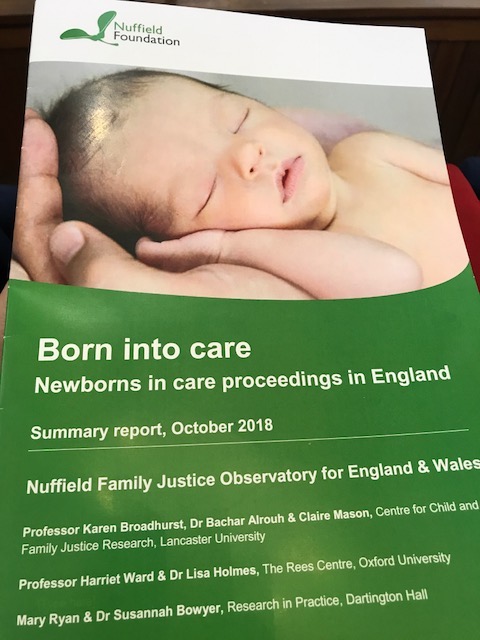On 9th October 2018 I attended the launch of the Summary Report of ‘Born into care: Newborns in care proceedings in England’ from the Nuffield Family Justice Observatory for England and Wales.
The Nuffield Family Justice Observatory aims to support the best possible decisions for children by improving the use of data and research evidence in the family justice system. The main report will be online as of 10th October; this post deals with a summary and overview of its main findings.
The focus of the report is new borns subject to care proceedings, ‘new born’ being defined as an infant less than 7 days old. ‘An infant’ is a child less than 12 months old. The study used CAFCASS data from 2007 to 2017 to provide the first estimate of what proportion of care proceedings for infants are issued for newborns.
Numbers are on the rise
In the decade covered by the study, 173,002 children were involved in care proceedings and 47,172 (27%) were infants. At the outset, 32% of care proceedings were for newborns – by the end that had increased to 42%. Newborn cases also increased in volume over time; at the outset 1,039 cases were issued involving newborns; at the end 2,447. Thus the likelihood of newborns in the general population become subject to care proceedings has more than doubled.
Regional variations
An alarming finding was the marked difference between the regions. The North West had the highest rates at 30 newborn cases per 10,000 live births in general population. Contrast this to London which had only 18 newborn cases per 10,000 live births. A minority of LAs departed significantly from the expected average – the range for such outliers in 2016 was between 55 and 159 newborns per 10,000 live births. This is clearly troubling, and we need to investigate more closely the reasons behind such regional disparity.
The report suggests that differences are most likely attributable ‘to an interaction between professional practice and socio-demographic factors’. Of particular interest to me was the suggestion that we should investigate the influence of the local Designated Family Judges. As it is a matter of some annoyance to me that different courts are developing divergent ‘local practice’ with regard to primarily administrative matters, it is not a great leap to think that a particular culture or approach may start to take root under the leadership of a particular Judge.
Subsequent Infants
This refers to newborns who had already had an older sibling appearing in care proceedings. In 2012/3 and 2016/7 this represented 47% of newborns. Without the experiences of an older sibling to inform the court, this raises issues about how the claim of ‘significant harm’ is going to be proved to the court – pregnancy provides only a very short window for an assessment of parenting capacity and support for change.
Duration of care proceedings
In 2012/13 only 28% of care proceedings completed within 26 weeks – in 2016/7 this increased to 61%. More research is needed to understand what is happening and what is different about the 39% of cases that do not complete within 26 weeks.
Final Legal orders
The total percentage of newborns subject to final care and placement orders was 47%. 21% were placed with extended family. 13% were placed with family. This requires further investigation – we need to know more about the circumstances behind those percentages.
Further questions
The report identifies the following areas requiring further consideration
- Is increasing financial hardship for families a factor in the rising rates of newborns in care proceedings?
- What is the impact of the reduction in preventative services on rates of newborns coming before the courts?
- Does a defensive risk averse culture mean that professionals are less likely to want to work with the family without the security of a court order?
- What accounts for fluctuations in the volume of newborn cases over time and place?
Main themes emerging from discussion
- Loss of empathy in the system. What’s going wrong when people in the system want to do their best. ‘The arms that we used to put around families – which are no longer there’.
- Development of ‘best practice’ in the maternity setting – how to make the whole experience of removal less brutal for mothers (and fathers). A lot of this would be fairly simple to adopt and wouldn’t cost a huge amount – so why aren’t we doing it?
- A need for better knowledge about what is done elsewhere – how do jurisdictions beyond England protect newborns, whilst also ensuring the rights of parents and wider family.
- We have the numbers – now we need to drill down and look at reasons WHY such care proceedings are initiated.
- And what happens AFTER proceedings? Are there groups of children who should be followed up?
https://twitter.com/SVPhillimore/status/1049593241341976576
https://twitter.com/SVPhillimore/status/1049644912575172608
https://twitter.com/SVPhillimore/status/1049648166075883520
Further reading
Care Crisis Review – report from the Family Rights Group
A little less conversation a little more action
Myths and Monsters of Child Protection

